
Inside the Boeing Archive. These are all films from Boeing's past. How awesome would it be to watch them all?
Boeing is one huge company. Currently, they have about 160,000 employees that do things from building planes to cleaning windows. The Boeing Company was first established in 1916 and has such an amazingly interesting history. What does a company like Boeing do to keep their history intact and make sure great ideas don’t fall between the cracks? I didn’t know, but I wanted to find out.
Recently I was fortunate enough to be invited to take a tour of the Boeing Archive and sit down with Boeing Historian Mike Lombardi. Since there was so much information to see and learn, I will present what I discovered in the archives in a three part series. In this first part, I will talk about the archives. Then in part two, I will share with you all the incredibly preserved Boeing models they have there. Finally, I will share my interview with Lombardi.
Even though most people associate Everett (Paine Field) and Renton (where 737’²s are made) with Boeing in the Seattle area, the archives are housed in a Boeing complex in Bellevue, WA, which is located just east of Seattle. The archive in Bellevue is the main corporate archive and preserves the history of Boeing and the aviation history of North American/Rockwell. The archives are for current commercial business as well as Boeing corporate.
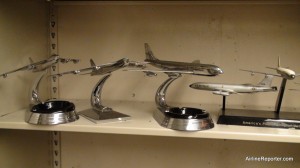
In the Vault: these classic Boeing ashtrays, which were very popular with Boeing engineers back in the day.
Over the years, the archive has grown to include other locations across the nation. There are the Douglas archives in Cypress, CA (near Long Beach), where the history of Douglas is preserved as well. It also houses Boeing’s current space and electronics related businesses that are in southern California. Boeing’s archive in St Louis takes care of the history of McDonnell Douglas and Hughes helicopters and supports their current military aircraft and defense business.
I was quite fascinated with the multiple levels of security attached to the Bellevue archive. First, guests must check-in at a public building to get their ’œEscort Required’ badge. Then, it is through a security gate where guests have to show said badge with their escort (who, for me, was the very helpful Bernard Choi with Boeing Communications). After the second security check, there are various doors one must go through that require a code before they reach the basement archives.

How cool would it be to have a few weeks to sit down and read all these?
Most of Boeing’s history is housed in an earthquake resistant basement, where computer chips used to be made. There are long rows of boxes with models (which I will talk about in Part 2), posters, films and trinkets almost everywhere. I was surprised. I was expecting just to see rows and rows of boring brown boxes, but there was a lot of great eye candy.
Inside another door to the side of the archives is a long room that is constantly air conditioned. In this room, one can find thousands of Boeing videos of pretty much everything Boeing has done since video was created. They are mostly on old school film. They have information on 16 and 35mm motion picture film, 35mm microfilm, VHS, 1’³ tape, 1/2 tape, 2’³ tape, Betamax, DAT, CD, DVD and Laser Disc. That isn’t even all the formats. Boeing is in the process of converting many of these items into digital formats.

The Boeing Archives needs to keep a lot of classic viewing machines around.
What a job it would be to watch the videos to convert them over?! I did hint to Bernard what a GREAT TweetUp it would make to show a few of these old videos (Boeing 707 test videos anyone) to the general public. Not only does Boeing keep all the old formats, but they also must hold on to all sorts of format players. From 8-tracks to Laser discs, they have a vast collection of media players that could serve as its own mini-museum.
After checking out the videos, I got to check out the vault. Another locked room in a series of locked rooms. I would love to tell you what was in the vault but I can’t, but let me tell you, it was amazing.
Ok, I am joking, I can tell you what was in the vaultpretty much all the prized possessions of Boeing’s past. Some of the items include gifts given to them by world leaders and items gathered by previous Boeing leadership. Also found in the vault are the meeting minutes dictating all the decisions ever made by Boeing and very valuable Boeing memorabilia. It was at this point I made the joke about how much all this stuff would sell for on Ebay. Heh, Mike didn’t find it funny (ok maybe a little bit). Mike has a heart for all things that are Boeing and he hates seeing important trinkets being sold on Ebay for money. Many families of Boeing employees who pass away will happily donate their loved ones Boeing items to be preserved in history. Mike told me he often gets emails from people trying to sell Boeing items, thinking they have deep pockets, but Boeing is not in the business of buying memorabilia.
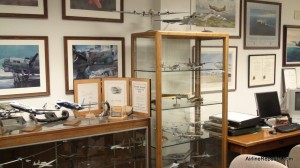
The Boeing Archive lobby had quite a few models, but that was nothing compared to what was inside the archives.
The archives are not just there to keep a hold of history. They are also there to help the future. Boeing engineers will often come to the archives so they don’t need to reinvent the wheel. If a Boeing engineer created a solution to a problem 30 years ago, current engineers can take a look at the old research and save time and money building off previous work.
So how does the general aviation nerd get access to the archives? Well the quick answer is that you can’t. They allow visits by non-Boeing guest on an extremely limited case-by-case basis. It is limited to academic researchers, the media, Boeing customers, museum staff, and established authors. However, enthusiasts can access Boeing archival information through the Boeing Images website. With Boeing making more of their archives digital and making more of an effort to connect with fans, we can hope that more of the fun stuff will be made public.
Even though I got to spend over an hour in the archives, I could have easily spent years without getting bored. Tomorrow, in Part 2, I will be posting about all the amazing models that are housed in the archives. In part 3, I will post an interview with Mike about his job and his thoughts on Boeing’s past, present and future. Stay tuned!
Inside The Boeing Company Archives
PART 1 | PART 2 | PART 3a | PART 3b | ALL PHOTOS | ALL STORIES
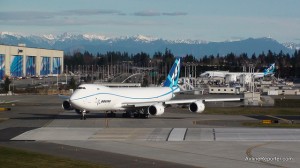
The first Boeing 747-8 completes taxi tests at Paine Field
Not that long ago Boeing entered into the world of social media and I wanted to take a moment to see how it is going.
Personally, I have seen huge changes in the past six months in regards to Boeing and social media. They have come an extremely long way when it comes to connecting with regular people like me and you since I started this blog just over two years ago. By making a huge push, I think they have been highly successful. However, I wanted to see how Boeing feels about their progress.
I decided to speak with Todd Blecher, Communications Director at Boeing based in Chicago, and Bernard Choi, who works for the Communications Department for Boeing Commercial Airplanes in Seattle, to hear their take on Boeing’s progress.
When I asked Blecher if he felt their efforts have been successful he responded with: “I look at success on two levels. The first is whether we consistently generate appealing digital content. The reactions we’ve received since we started using Boeing.com as a storytelling platform and engaging through Twitter lead me to believe that we do.”
Blecher admitted that he wished their numbers were a little higher for the unique content they are creating on their website, but they were very happy with how their efforts at Farnborough turned out. “Our Farnborough micro site was a watershed moment, coming just a few months after we began communicating differently through Boeing.com,” Blecher stated. “We attracted 103,710 visitors who made more than 225,000 visits and 222,300 views of our videos. That was remarkable for us. I’m very proud of that effort.”
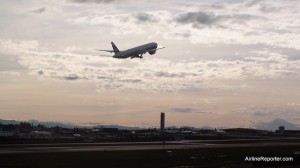
A new Cathay Pacific Boeing 777 test flying at Paine Field
On top of making a lot of great and unique content on their website, Boeing has also been making a great effort to interact with their employees, different airlines and fans on Twitter.
I have found that a lot of companies don’t know how to make Twitter work for them. Many will have a Twitter account because they feel they need one, but they don’t know why. Talking with Blecher, I can tell he gets it. “Social media’s value rests in allowing organizations to engage in a dialogue with people around the world that can benefit both sides of that equation, and do that at very low cost,” he explained. Boeing is not on Twitter because they want to look like they are in-touch, they are on Twitter because they want to change how they communicate to the outside world (being media, airlines and fans like you) permanently and more effectively, using technology.
Working Boeing’s three Twitter accounts (@BoeingAirplanes, @BoeingCorporate and @BoeingDefense) is very much a team effort. Blecher watches over @BoeingCorporate, Choi works on @BoeingAirplanes and Maribeth Bruno in Boeing Defense Communication watches over @BoeingDefense. I know that some larger companies have to go through a lot of hurdles to get something posted to Twitter, but Boeing makes it easy.
I have heard of horror stories from other companies, where they want to Tweet something, but it has to be approved half way around the world by five different people. It might take up to 12 hours to finally Tweet and by then, the moment is lost.

Boeing's hangars in Everett, WA (don't worry I was passenger when taking this photo)
Blecher pointed out that Boeing is actually pretty flexible with allowing people to Tweet. All three of them that oversee the Twitter accounts are trained professionals and are able to use their own judgment on what is alright to Tweet. “Since our tweeters are media relations people by trade we all know what’s ok and what’s not ok for a tweet.” Blecher continued, “We’re used to being on a high wire without a net, so to speak. Therefore, most of our tweets aren’t subjected to lengthy review.”
He did clarify that if a Tweet is program related (ie what the 787 might be doing), they will speak with people in that department to make sure they have accurate information. On rare occasions there might be longer discussions before a Tweet goes public.
Choi explained that he might confer with a colleague, but he has the ability to use his judgment when to make a Tweet go live, “I’ll bounce ideas off of my colleagues, but there isn’t an official approval process.” There is a lot going on at Boeing all the time and it can’t all be Tweeted. I asked Choi how he gets his information, like when Randy Tinseth posts a new blog, does he get a heads up? He explained that sometimes he might, “get a heads up that Randy’s got a new blog coming or I’ll just wait like everyone else. I don’t tweet every blog entry, just as I don’t tweet every Boeing news release. It’s fairly subjective. We don’t want to overtweet, so we look for the highlights or just interesting nuggets to tweet. As you can imagine, we’re still learning as we go.” And Boeing has been learning.
Let’s take a look at what happened just last night. Boeing knew it was going to have to announce that the Boeing 787 will be delayed again. They posted their press release and Tweeted out the delay pretty much at the same time. Even though there were rumors that Boeing would release this information, they were the first one on Twitter to have the official confirmation. It was about another 15 minutes before other Twitter people responded to their original Tweet. That is being proactive and not everyone would be willing to Tweet out bad news like that.
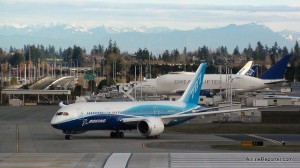
Boeing 787 Dreamliner ZA001 during its taxi testing with Dreamlifter in the background.
Boeing has learned a lot from their interactions on Twitter, from posting online media and their Boeing Store Facebook account. They are hoping to use that information to continue to grow their online presence. They hope to launch an official Boeing Facebook page (there is currently an unofficial one with 30,000 fans) and YouTube channel to share videos with the public and believe me, they have some really cool stuff.
Speaking about cool stuff, Boeing is still hip with the idea of having a TweetUp sometime. That is where a bunch of airline nerds like us (don’t take offense to that, just figure you might be one if you’re reading this) get together and talk about airplanes and do some cool things (there was one last year called Aviation Geekfest). One sponsored by Boeing won’t happen soon (there is a lot of red tape), but they are motivated to try and make it work someday (And I will continue to keep reminding them).
They are currently happy with the progress they have made, yet are still cautious about growing their online presence too quickly. “With any of these tools we have to walk before we run,” Blecher explained. “We’re far ahead of where I expected we’d be and while I’d love for us to be moving faster, I realize that trying to move too fast could put our efforts at risk. A couple of high-profile mistakes in the social sphere could really set us back.” That is a very wise approach to take. Many airlines have hopped on to the online bandwagon with great momentum, just to fizzle out with time and leaving people wondering what happened. You also don’t want to be venturing into new technology without fully understanding the impact it could have on your business or your customers.
From speaking with Blecher and Choi multiple times through their transition, I constantly get the feeling that they get it. They aren’t just pushing Boeing into the online realm because it is the new fad. Boeing is very well known for being innovative and cutting edge in many of the things they accomplish. Now they want to take that Boeing innovation mentality to the way they communicate with the outside world.
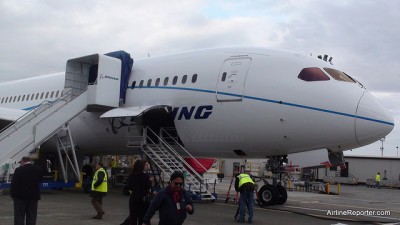
Boeing 787 Dreamliner ZA003 at Paine Field
Boeing tonight announced another delay in the 787 Dreamliner program. Normally this means comments on new sites will fill with frustration on Boeing inability to get this plane to market. I have some opinions of my own, but before I give them, here is the press release that Boeing released tonight:
The Boeing (NYSE: BA) Company said today that it now expects delivery of the first 787 in the middle of the first quarter 2011.
The delivery date revision follows an assessment of the availability of an engine needed for the final phases of flight test this fall.
While Boeing works closely with Rolls-Royce to expedite engine availability, flight testing across the test fleet continues as planned.
Boeing said last month that the cumulative impact of a series of issues, including supplier workmanship issues related to the horizontal stabilizer and instrumentation delays, could push first delivery of the 787 a few weeks into 2011. The delay in engine availability has extended that estimate to mid-first quarter 2011.
The schedule revision will not affect the company’s financial guidance.
Of course this is something that Boeing is not happy about. Heck it is something I am not happy about either. The 787 has already been plagued with delays. The first issue, in my opinion, was that Boeing made a timeline of completion that was too aggressive and unrealistic. Then we get the workmanship issue with the horizontal stabilizers that wasn’t good and also the more recent failure of a Rolls Royce Trent 1000 engine. However, I feel all these delays will easily be forgotten shortly after the Dreamliner makes it to the market. Remember, this is a very complex aircraft that represents the next generation of airliners.
When Boeing first introduced their first jetliner, the Boeing 707 it was easy to tell it was a totally new type of airplane. It looked unique sporting jet engines instead of props. I feel that the Boeing 787 Dreamliner, like the 707, is the next generation of airliner of its time. I think people have a hard time realizing that, since it doesn’t look all that different from current airlines. Boeing is not the only one experiencing delays building the airplanes of the future.
As Airbus continues to work on their next generation airplane, the Airbus A350, they are not immune to their own delays. Flight Blogger is reporting that the first delivery of the A350 will be delayed until at least 2014. It is still very early on in their process and even though they have learned a lot from Boeing’s delays, I assume this won’t be the last delay for the A350 we will hear about.
Creating the next generation of aircraft is not easy. It has taken some of the best minds in the world at Boeing and Airbus to move both of these programs forward. With with all the know-how, money and drive to succeed, there will be bumps in the road. Previous airliners have seen delays as well through out history and most of those delays are quickly forgotten.
This makes me very sad that I will have to wait a few more months to see the first Boeing 787 in ANA livery carrying passengers. But I tell you what… the first time I am able to fly in a Dreamliner, it will be totally worth the wait!
Shout out to Jon @ FlightBlogger for following this story.
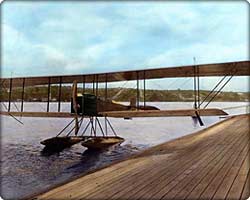
B & W Seaplane, the first Boeing plane, named after Boeing Founder, William Boeing
Tomorrow morning (Thursday) I will have the great opportunity to sit down with the Boeing Historian for an interview. I feel overwhelmed with questions I could and want to ask.
However, I want to share this opportunity with you as well. What questions do you have for the Boeing Historian? Either leave them as a comment or email them to da***@*************er.com and if I am wondering the same thing, I will ask!
Image: Boeing
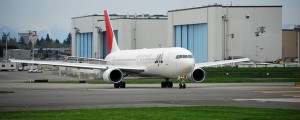
Japan Airlines 767-300 at Paine Field
Boeing recently did a little re-arranging at their Everett facility for the 767 line (check out Boeing’s video). Moving 200-tons of tools is not easy, but neither is making Boeing aircraft. Instead of taking apart the tooling apparatus and re-constructing it, Boeing decided to move it like an old house. Boeing hired an outside team to jack up the apparatus and drive it to its new location.
This move will decrease the number of days to make a Boeing 767 and increase the amount of space available on the production floor. The Boeing 737 and 777 programs completed a similar change a while back. A big change from previous lines is the exit for the line will be in back of the hangars and not the front.
Now, this just leaves the question, “why?” Boeing currently only has three orders for the 767 all from Azerbaijan Airlines, but there are 55 in the backlog waiting to still be built. The 767 was first introduced almost 30 years ago and there have almost been 1000 built. Many see the Boeing 787 as the replacement for the 767, so why put this money into an aging product?
I can only imagine this move is preparing to build the next generation of military tanker using the Boeing 767 frame. I was curious if Boeing would still plan to produce 767’s if they don’t win the tanker bid and I heard back from Leslie Hazzard, with Boeing Commercial Airplanes Communications.
She told me, “We continue to market and sell the 767 and plan to continue building it as long we see customer demand for the airplane. If we win the U.S. Air Force contract for replacement aerial refueling tankers, we will integrate Tanker production with commercial airplane production on an ITAR-compliant production line.”
It looks like Boeing is planning to win the contract and I feel they most likely will. If they don’t win the contact, will there be enough of a need for an updated Boeing 767 and a Boeing 787? That, I am not so sure about.
Image: Sabian404











